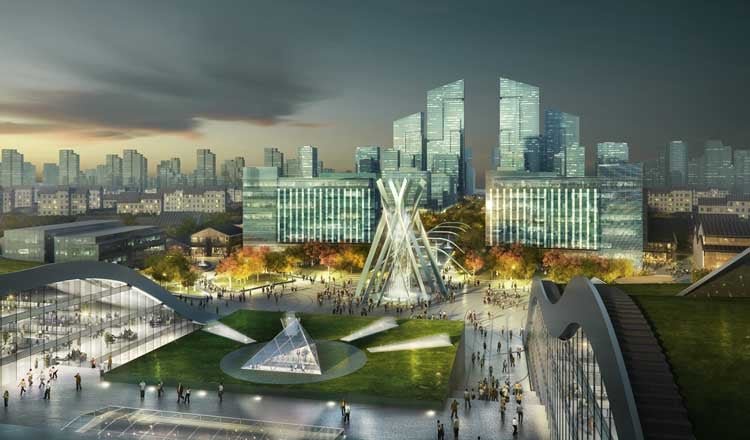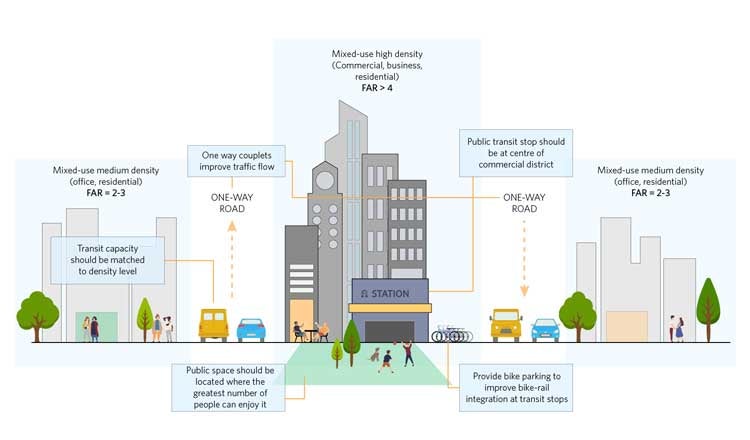
Ending Global Sprawl: Build Transit-Oriented Developments (TODs)
This article was originally published in Ending Global Sprawl: Urban Standards for Sustainable and Resilient Development, written by Peter Calthorpe and published by the World Bank's Global Platform for Sustainable Cities. Ending Global Sprawl explores forward-thinking planning strategies for the urban form.
Principle 4: Build Transit-Oriented Developments (TODs)
Match land-use density and mix to transit capacity in a walkable environment.
Rationale and Challenges
TODs are the areas directly surrounding transit stations and transit corridors that should be dense, mixed-use and walkable. They should form the structure of a city and regional master plan to focus density and commercial destinations around transit. Public transit and walking must be the preferred travel mode for a majority of household trips in TODs, thereby reducing congestion, improving air quality and reducing carbon emissions.
Increasing the density of people working and living close to transit is one of the best ways to make all the forms of shared mobility more convenient and successful. TODs reduce auto trips by increasing the availability of goods and services within easy walking or biking range of a station. TODs across the globe are proving to be more desirable places to live and work by creating complete communities with practical transportation options.
The challenges to realizing this simple concept are complex. In many cities, the automobile has come to dominate the primary mode of circulation, rendering transit a second-class alternate. In fact, the road and parking demands of auto-based districts contradict the fundamental needs of TOD.
Where transit is present and growing, the challenge is to shape land use around stations into walkable neighbourhoods and commercial districts that make auto-free living a convenient and good choice. This means distributing density and mixed-use in appropriate proportion to the level of transit service.
TOD offers a fundamental opportunity for cities: to create mixed-use districts that distribute jobs, housing and services in a way that enhances the convenience of transit and makes for an area with great walkable city life. TODs should become the building blocks of the urban fabric at the neighbourhood, district and regional level.

Goals and Actions
4A: Create higher-density mixed-use nodes around transit
- ACTION 1: Increase walkability, mix and a sense of place with civic uses, parks and plazas at stations and along transit corridors
- ACTION 2: Match density to transit capacity using a hierarchy of TOD types through both redevelopment and new construction
- ACTION 3: Concentrate major commercial and retail development in high-capacity TOD areas
4B: Design transit stations with convenient walking and bike routes to homes, jobs and services
- ACTION 4: Ensure convenient and safe entrances to transit stations free of major auto traffic
- ACTION 5: Emphasize bike and pedestrian access to stations by integrating bike parking and shops
Metrics
4.1: Density Standards
For each TOD type, meet the population and employment density guidelines
4.2: Limit Parking
Set maximum commercial parking ratios; parking ratio for TOD areas should be at most 80% of the city standard
4.3: Parks in TOD
Provide for a minimum of 10% of developable land area for parks and 5% for civic uses in each TOD

Benefits
Economic
- Ensures successful mobility: The ability for people and goods to move efficiently is a fundamental requirement for economic growth. TOD is an essential strategy for managing growth in terms of land, energy and public funds.
- Spurs private investment due to transit access: 67% of major transit investments in North America were followed by investments in new buildings that exceeded the cost of the transit upgrade.
- Increases returns on transit investment: Allocating density around transit stops will increase ridership, thus leading to better returns on transit investment.
Environmental
- Decreases carbon emissions: Residents of transit-oriented developments are two to five times more likely to use public transit than others who live in the same region. Transit-oriented development also produces fewer emissions than traditional suburban development.
- Conserves land and natural resources: Transit-oriented development can re-direct population growth at a higher density to economically vibrant areas with good transit connections, which conserves land and natural resources.
Social
- Increases mobility for disadvantaged groups: Increasing building density and allowing for more population and job density at TOD increases the effectiveness of public transport as well as equitable transit access for the entire community.
- Builds social ties: Compared to auto-oriented urban environments, TODs can mix activities while diverse groups help to build social ties and a sense of community.
About the Author: Peter Calthorpe

Peter’s long and honoured career in urban design, planning and architecture began in 1976, combining his experience in each discipline to develop new approaches to urban revitalization, suburban growth and regional planning. In 1983, Peter founded the award-winning firm of Calthorpe Associates devoted to sustainable urban design and planning globally. In May 2019, Calthorpe Associates joined HDR. Throughout his career in urban design, planning and architecture, he has been a pioneer of innovative approaches to urban revitalization, community planning, and regional design. For his contribution to redefining urban and suburban growth models, he was awarded Urban Land Institute's prestigious J.C. Nichols Prize for Visionaries in Urban Development in 2006. He is one of the founders and the first board president of Congress for the New Urbanism. Metropolis Magazine claims: "The titles of Peter Calthorpe’s books define the recent history of urban design in its most vital and prescient manifestations."

